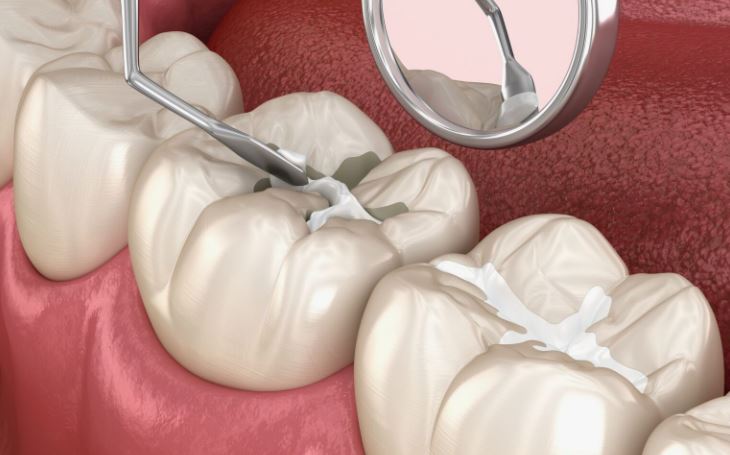Guide to Dental Fillings: A Step-by-Step Journey to a Healthy Smile

Guide to Dental Fillings: A Step-by-Step Journey to a Healthy Smile
If you have ever experienced sensitivity to hot and cold while eating you most probably would have been advised to go for dental filling. But what actually are dental fillings? The term is normally used for dental conditions like enamel deterioration, cavities, or cracks within teeth. Dental fillings are a safe option because they not only preserve the original tooth shape in case of chipping or deterioration but also help with painful nerve endings and hot and cold sensitivity.
The Types of Dental Fillings & Their Uses
- Amalgam Fillings (Silver Fillings): These are made of several metals, including silver, mercury, tin, and copper. Since the rear teeth take higher bite force, they are a preferred option for filling cavities because of their strength and endurance.
- Composite Fillings (Tooth-Colored Fillings): Fine glass particles mixed with plastic are used to make composite fillings. In particular fillings in the front teeth, they are made to match the color of your teeth for a natural-looking result. These fillings are also bonded directly to the tooth structure, making them more durable and less likely to crack or break.
- Gold Fillings: As the name suggests, gold fillings are made from a gold alloy. They are highly durable and resistant to corrosion, making them a long-lasting option. However, they are also more expensive and may require multiple visits to complete.
- Porcelain Fillings: Porcelain fillings are made from a glass-like material that can be tinted to match the color of your natural teeth. They are highly durable and stain-resistant, providing a natural-looking and long-lasting solution. Nevertheless, they could need more tooth preparation and are also more costly.
The cost, longevity, appearance, and compatibility for various oral regions vary for each type of filling. Your dentist can aid you in deciding which choice best suits your needs.
Getting Ready for Dental Filling Surgery
During the appointment, your dentist will assess your teeth and determine the decay extent. X-rays may be taken to determine if a filling is needed and to assess the issue’s severity.
Your dentist might suggest a temporary filling in specific circumstances. Until the final infill is constructed, this is a stopgap approach to protect the region.
The Step-by-Step Dental Filling Procedure
An easy and successful dental filling operation depends on your ability to understand each step of the process.
Step 1: Numbing for Comfort
Your dentist will numb the region surrounding the damaged tooth with a topical numbing gel or a local anesthetic injection prior to the operation starting. This guarantees your ease and painlessness during the process.
Step 2: Taking Out Decay
Your dentist will use a dental drill or laser to carefully remove any decayed or damaged tooth material after numbing that region. Removing all decay is vital to prevent its spread and ensure a solid filling foundation.
Step 3: Filling Material Selection
After decay removal, your dentist will choose the filling material considering the tooth’s location, your preferences, and other factors.
Step 4: Placing the Filling
Your dentist will meticulously form and mold the selected filling material to precisely fit the natural curves of your tooth.
Step 5: Curing (if applicable)
For a composite filling, your dentist uses a curing light to harden and attach the material to your tooth. This step ensures a durable restoration.
Your dentist will take all required safety and comfort measures throughout the treatment. They could also give you information on how to take care of your newly placed filling and encourage healing after the procedure.
Post-Treatment Care and Follow-up
This can involve maintaining proper dental cleanliness, setting up frequent follow-up appointments, and temporarily abstaining from particular foods or activities.
It is very important to uphold hygienic dental practices. Do not forget to add the following to your regular routine:
- Scheduled dental cleanings and examinations
- Flossing
- Brushing with Fluoride toothpaste
This practice ensures dental fillings longevity and avoids enamel deterioration in the future.
Get in touch with your dentist if your filling is causing you any discomfort or worries. They can handle any problems and offer advice on how to take good care of your teeth.
Parting Words
Keeping a beautiful smile and preserving good oral health requires an understanding of the dental filling procedure. You may make knowledgeable judgments and have confidence in the care you receive if you are aware of the many filling kinds, the methodical process, and the significance of post-treatment care.
Personalized care and patient education are our top priorities at the Ramlaoui D.D.S. clinic. Our skilled dentists are committed to giving you dental fillings of the greatest caliber and making sure you have a stress-free, comfortable experience. Make an appointment with Ramlaoui D.D.S. right now to start along the path to a brighter, healthier smile!
20-06-2024

